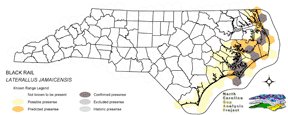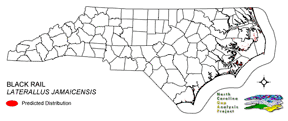
| Taxa: |
| Order: |
| Family: |
| Aves |
| Gruiformes |
| Rallidae |
| NatureServe Global Rank: |
| NatureServe State (NC) Rank: |
| G4 |
| S3B,S2N |
| Federal Status: |
| NC State Status: |
| FSC |
| SR |


| Land Unit |
| US Fish & Wildlife Service |
| US Forest Service |
| US National Park Service |
| US Department of Defense |
| NC State Parks |
| NC University System |
| NC Wildlife Res. Com. |
| NC Forest Service |
| NC Div. of Coastal Mgmt. |
| Local Governments |
| Non-Governmental Org. |
| Other Public Lands |
| Private Lands |
| GAP Status 1-2 |
| All Protected Lands |
| Statewide |
| Hectares |
| 19,636.65 |
| 288.00 |
| 8,948.97 |
| 6,369.93 |
| 1,238.85 |
| 123.03 |
| 4,409.64 |
| 0.00 |
| 1,425.06 |
| 4.86 |
| 1,956.51 |
| 34.83 |
| 60,242.85 |
| 31,673.79 |
| 43,891.29 |
| 104,679.18 |
| Acres |
| 48,523.21 |
| 711.66 |
| 22,113.38 |
| 15,740.44 |
| 3,061.26 |
| 304.01 |
| 10,896.46 |
| 0.00 |
| 3,521.40 |
| 12.01 |
| 4,834.64 |
| 86.07 |
| 148,863.30 |
| 78,267.62 |
| 108,457.72 |
| 258,667.84 |
| % of Dist. on |
| Prot. Lands |
| 44.7 % |
| 0.7 % |
| 19.2 % |
| 14.5 % |
| 2.8 % |
| 0.3 % |
| 10.0 % |
| 0.0 % |
| 3.2 % |
| 4.5 % |
| 4.5 % |
| < 0.1 % |
| 0.0 % |
| 72.2 % |
| ----- |
| ----- |
| % of Dist. on |
| All Lands |
| 18.8 % |
| 0.3 % |
| 8.5 % |
| 6.1 % |
| 1.2 % |
| 0.1 % |
| 4.2 % |
| 0.0 % |
| 1.4 % |
| < 0.1 % |
| 1.9 % |
| < 0.1 % |
| 57.5 % |
| 30.3 % |
| ----- |
| ----- |
|
NATURE SERVE GLOBAL HABITAT COMMENTS: Salt, brackish, and freshwater marshes, pond borders, wet meadows, and grassy 'swamps.' Cover of vegetation peripheral to marsh may possibly be important in reducing predation on rails flushed from marsh by high tide (Evens and Page 1986). Secretive but may emerge from cover in early morning. Nests in or along edge of marsh, in area with saturated or shallowly flooded soils and dense vegetation, usually in site hidden in marsh grass or at base of Salicornia; on damp ground, on mat of previous year's dead grasses (Terres 1980), or over very shallow water. High tides may destroy nests (see Evens and Page 1986). In northeastern North America breed primarily in salt and brackish marshes (Davidson 1992). However, wet meadows and freshwater areas of narrow-leaved cattail (TYPHA ANGUSTIFOLIA) and river bulrush (SCIRPUS FLUVIATILIS) have also been documented (Griscom 1923, Proctor 1981, Armistead 1990). In salt or brackish marshes, home ranges generally include dense stands of saltmeadow cordgrass (SPARTINA PATENS) mixed with saltwater cordgrass (S. ALTERNIFLORA), big cordgrass (S. CYNOSUROIDES), marsh spikegrass (DISTICHLIS SPICATA), black needlerush (JUNCUS ROEMERIANUS), black rush (J. GERARDI), or Olney's threesquare (SCIRPUS OLNEYI) (H. Wierenga pers. comm., Kerlinger and Wiedner 1990). Also occur in the dryer, upland edges of these marshes where saltmeadow cordgrass mixes with marsh elder (IVA FRUTESCENS) and groundsel tree (BACCHARIS HALIMIFOLIA) in the saltbush community and with common reed (PHRAGMITES AUSTRALIS) in disturbed areas (Kerlinger and Wiedner 1990). Research in wetlands along the lower Colorado River has revealed that water depth is an important and perhaps key habitat component. Black rails there are found typically where the water depth is less than two to four cm (R. Flores, pers. comm.). Other significant habitat factors may include vegetation density, distance to open water, and water regime stability (R. Flores, pers. comm.). Nesting takes place in the highest sections of the marsh, which have mesic to hydric soils and are flooded by only the highest tides (Todd 1977, Andrle and Carroll 1987). The area around the nest also typically includes lower wet areas, such as shallow pools and potholes (Andrle and Carroll 1987; W. Burt, W. R. Eddleman, and H. Wierenga, pers. comms.). |
| Code | Name | Description | NC Natural Heritage Program Equivalent |
| 3 | Tidal Marsh | Fresh and brackish tidal marshes, including cord grass, wild rice, sawgrass and needlerush alliances. | Brackish Marsh, Interdune pond, Maritime wet grassland |
| 124 | Maritime Scrubs and Tidal Shrublands | Coastal shrubs including wax-myrtle, swamp rose, alder, yaupon, and greenbriar. | Maritime Shrubs, Salt Shrub |
| 372 | Interdune Herbaceous Wetlands | Dune swales with permanently flooded to intermittently exposed hydrology. Species composition depends on salinity and can include cut grass, spike-rush, mosquito fern, and hornwort. | Interdune Pond, Maritime Wet Grasslands |
| 380 | Coastal Plain Fresh Water Emergent | Emergent vegetation in fresh water seepage bogs, ponds and riverbeds of the coastal plain. Includes alliances dominated by sedges, eelgrass, as well as cane found in unforested cane-brakes. | Small Depression Pond, Sandhill Seep, Floodplain Pool, Unforested Floodplain Canebrake, Riverscour Prairies, Vernal Pools |
| 173 | Coastal Plain Riverbank Shrubs | Shrub dominated riverbanks, commonly dominated by willows and/or alders. | Sand and Mud Bar |
|
Todd, R. L. 1977. Black rail, little black rail, black crake and farallon rail (LATERALLUS JAMAICENSIS). Pages 71-83 in G. C. Sanderson, editor. Management of migratory shore and upland game birds in North America. Int. Assoc. Fish and Wildl. Agencies, Wa
Proctor, N. 1981. The black rail:mystery bird of the marsh. Connecticut Warbler 1(2):15-16. Carter, M., G. Fenwick, C. Hunter, D. Pashley, D. Petit, J. Price, and J. Trapp. 1996. Watchlist 1996:For the future. Field Notes 50(3):238-240. Griscom, L. 1923. Birds of the New York City region. American Museum of Natural History, Handbook Series No. 9, New York, New York. 400 pp. Bent, A. C. 1926. Life histories of North American marsh birds. U.S. National Museum Bulletin No. 135. [reprint. 1963. Dover Publications, Inc., New York, New York]. Ehrlich, P.R., D.S. Dobkin, and D. Wheye. 1992. Birds in jeopardy:the imperiled and extinct birds of the United States and Canada, including Hawaii and Puerto Rico. Stanford University Press, Stanford, California. 259 pp. Herkert, J. R., editor. 1992. Endangered and threatened species of Illinois:status and distribution. Vol. 2:Animals. Illinois Endangered Species Protection Board. iv + 142 pp. Kerlinger, P., and D. S. Wiedner. 1990. Habitat use and vocal behavior of black rails in South Jersey. Unpublished draft report. New Jersey Department of Environmental Protection, Endangered and Nongame Species Program. 18 pp. Hands, H.M., R.D. Drobney, and M.R. Ryan. 1989. Status of the black rail in the northcentral United States. Missouri Coop. Fish Wildl. Res. Unit Rep. 11 pp. California Department of Fish and Game. 1990. 1989 annual report on the status of California's state listed threatened and endangered plants and animals. 188 pp. Armistead, H. T. 1990. Notes on black rails on the Delmarva Peninsula, especially in Dorchester County. Unpublished report. Maryland. Maryland Department of Natural Resources, Annapolis, Maryland. 6 pp. Ripley, S.D. 1977. Rails of the world. M.F. Feheley Publishers, Ltd., Toronto. 406 pp. Harrison, C. 1978. A field guide to the nests, eggs and nestlings of North American birds. Collins, Cleveland, Ohio. Harrison, H.H. 1979. A field guide to western birds' nests. Houghton Mifflin Company, Boston. 279 pp. Terres, J.K. 1980. The Audubon Society encyclopedia of North American birds. Alfred A. Knopf, New York. American Ornithologists' Union (AOU), Committee on Classification and Nomenclature. 1983. Check-list of North American Birds. Sixth Edition. American Ornithologists' Union, Allen Press, Inc., Lawrence, Kansas. Evens, J., and G. W. Page. 1986. Predation on black rails during high tides in salt marshes. Condor 88:107-109. National Geographic Society (NGS). 1983. Field guide to the birds of North America. National Geographic Society, Washington, D.C. Raffaele, H.A. 1983. A guide to the birds of Puerto Rico and the Virgin Islands. Fondo Educativo Interamericano, San Juan, Puerto Rico. 255 pp. Evens, J. G., et al. 1991. Distribution, relative abundance and status of the California black rail in western North America. Condor 93:952-966. Stiles, F.G., and A.F. Skutch. 1989. A guide to the birds of Costa Rica. Comstock Publ. Associates, Cornell University Press, Ithaca, New York. 511 pp. Davidson, L. M. 1992. Black rail, LATERALLUS JAMAICENSIS. Pages 119-134 in K. J. Schneider and D. M. Pence, editors. Migratory nongame birds of management concern in the Northeast. U.S. Fish and Wildlife Service, Newton Corner, Massachusetts. 400 pp. |
For more information please contact them at:
NC-GAP Analysis Project
Dept. of Zoology, NCSU
Campus Box 7617
Raleigh, NC 27695-7617
(919) 513-2853
www.basic.ncsu.edu/ncgap